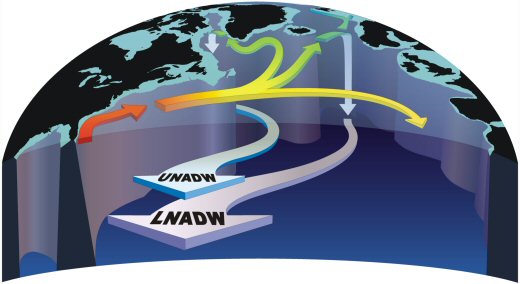
The formation of North Atlantic Deep Water. Cold, dense, deep water forms in two areas of the northern North Atlantic Ð in the Labrador Sea (between Greenland and Canada) and in the GIN Sea (between Greenland, Iceland and Norway). Because it originates in the North Atlantic it is known as North Atlantic Deep Water (NADW). Ocean scientists can recognize NADW by its salinity and temperature, which is about 2.5 - 5 °C for the water from the Labrador Sea and about 0 - 2.5 °C for the water from the GIN Sea 1). Due to its higher temperature deep water from the Labrador Sea is a little less dense, and flows southwards above the colder water from the GIN Sea. This creates two distinct layers of North Atlantic Deep Water - an upper layer (UNADW) that forms in the Labrador Sea, and a lower layer (LNADW) that forms in the GIN Sea.
By measuring the southward flow of North Atlantic Deep Water oceanographers may get important information about the strength of the thermohaline circulation. A reduction in the southward flow of NADW indicates a slow-down of high-latitude sinking, and therefore a reduction in the northward movement of warm surface water Ð at least the part of the flow that is due to the THC rather driven by the wind. If the flow of UNADW and LNADW are monitored separately, we may also learn where deep-water formation has been reduced. Thus a change in the flow LNADW may indicate a change in the GIN Sea, and in turn a possible change in the flow of warm Gulf Stream water towards the shores of north-west Europe.
1) The temperatures given here are potential temperatures - that is the temperatures these water masses would have if they were at the sea surface.